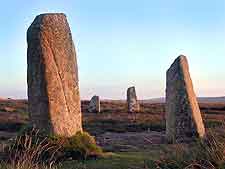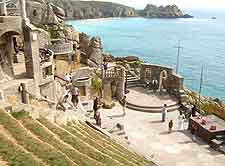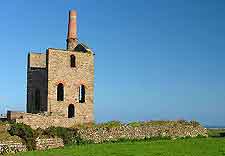Penzance History Facts and Timeline
(Penzance, Cornwall, England, UK)

The earliest known building on the site of the present town of Penzance is thought to be that of an Iron Age hill fort. Known as Lescudjack Castle, it covered a large area of land and consisted of a wall made from stone and earth.
Early History to the Middle Ages
In the 13th century, a church was built on the headland to the west of Penzance Harbour. Originally named Pen Sans, meaning 'holy headland' in the native Cornish language, this ancient Christian chapel was thought to contain a statue of St. Anthony.
By the 14th century, what had once been a small fishing village had grown into a town. In 1404, Henry IV granted Penzance a Royal Market. Then in 1512, Penzance was given a Royal Charter that gave the town the right to charge harbour dues. During the years of history that followed, the town became increasingly prosperous.

Plague and Plunder
Then, in the summer of 1578, trouble struck the town in the form of the plague. Around ten percent of the population died as a result. Plague was to visit the town again in 1647, leading to many further deaths.
In 1595, the town suffered another setback when it was set upon by a party of Spaniards following the defeat of the Spanish Armada. The raiders set fire to the town, destroying many buildings. Some 20 years later, much of the damage had been repaired and the rebuilt town was granted a Charter of Incorporation by King James I. As well as having a mayor, Penzance could hold seven fairs a year and two weekly markets.
In 1646, during the English Civil War, Penzance was once again plundered. It was thought to be in retribution for the kindness shown to Royalist troops by the townsfolk. By 1663, peace had been restored. King Charles II once again confirmed the town's Charter and granted the right to mint coins. Penzance now played an important role in the region's commercial activities.

18th and 19th Centuries
By the 18th century, Penzance Harbour had become a bustling port and a centre of local commerce, mainly related to the tin mining industry. In 1766, the Old Pier was built. This was extended during the late 17th and early 18th centuries, while a lighthouse was constructed in 1817. In 1855, both pier and lighthouse were strengthened. A rail line was built in 1847, which ended at the Albert Pier. Penzance Railway Station opened in March 1852, linking the town with
Bristol,
London and the north of England. By 1853, the town had a lifeboat of its own. Then, in 1884, an inner harbour was built.
By the 19th century, the mining industry in Penzance was at its peak. Its most famous resident, Sir Humphry Davy, invented the miners safety lamp here in 1801. It was to revolutionise working conditions for those toiling away in Britain's mines. The town also boasted its own mining school, founded in 1890.
Present-day Penzance
Today, the town enjoys a healthy summer tourism industry, with many holiday makers choosing Penzance as a base for their travels around the south-western tip of Cornwall. Nearby, St. Michael's Mount holds a fascinating history all of its own, as does Lands End, Mousehole and Porthcurno.
 The earliest known building on the site of the present town of Penzance is thought to be that of an Iron Age hill fort. Known as Lescudjack Castle, it covered a large area of land and consisted of a wall made from stone and earth.
The earliest known building on the site of the present town of Penzance is thought to be that of an Iron Age hill fort. Known as Lescudjack Castle, it covered a large area of land and consisted of a wall made from stone and earth.
